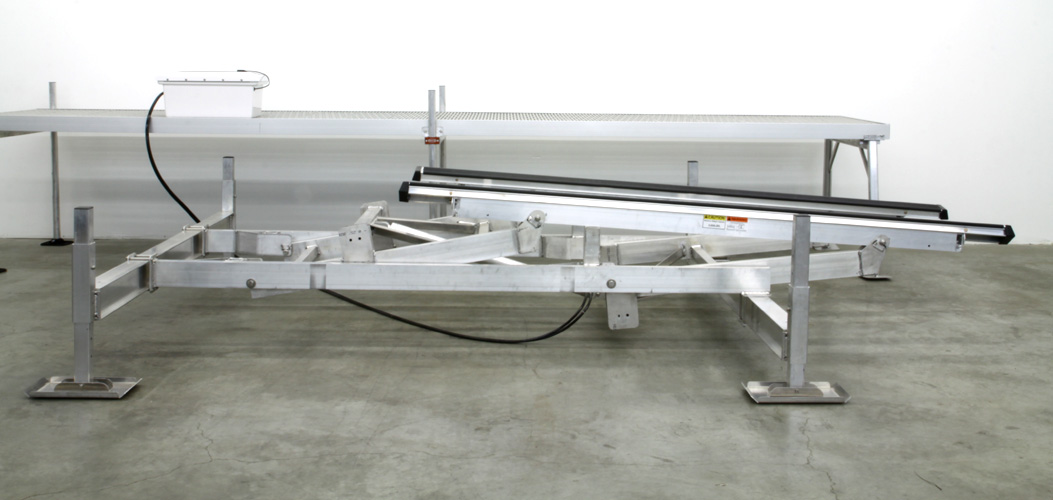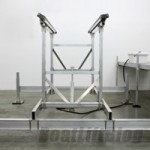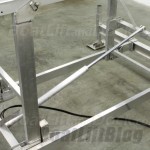Boat Lift Styles
Hands down, one of the most important pieces of equipment on the waterfront is the boat lift. No other tool does more to get your boat, and you out on the water, so choosing the right design for your needs is essential. The standard boat lift design uses a square rack or cradle that is operated by a winch and/or motor that uses cables to perform the lift. This is a very common design and one that gets the job done without too much hassle; smoothly raising and lowering millions of boats the world over. However, there are alternatives to cable driven systems that are designed to lift your craft in vertical lift or cantilever lift styles that bring a nice alternative to the boating lifestyle.
Hydraulic Boat Lift
The main benefit of the hydraulic powered system is its speed and sheer power or capacity to lift. With cable designs, the layout of the cables has to be distributed across the lifting cradle through a series of pulleys that route the cables in such a way that the lift action is balanced and smooth. This creates several contact points where ware can accumulate and parts can fail. Not only can the pulley’s themselves ware out but the cables can fray and break over time from corrosion, excessive weight, or improper installation and operation; in short the more links in your chain, the greater the chance for a weak link to emerge.
Craftlander Hydraulic Lift
To be clear, the cable lift design is tried and true and there is no reason to doubt this style of lift, however, the Hydraulic boat lift from CraftLander utilizes a cantilever design that employs a single hydraulic cylinder that will get your boat up or down quickly and smoothly. Featuring an Over-Center Gravity Lock design, this lift will remain in the up position even if the cylinder fails, eliminating the possibility of your boat lowering on its own and floating off of the lift.
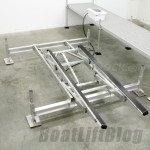 One feature to be aware of is the fact that in the down position the cylinder is submerged and even though it is sealed this increases the chances of water penetration and difficulties down the line. Also, with the cantilever design the centering of the boat on the lift becomes very important. Back in the day, as they say, the main benefit to a cantilever design was that you could essentially lay the rack on the lake bottom, getting your boat off of the lift in shallow conditions. However, these days, most vertical lifts are designed to get the cradle as low as possible to accommodate for shallow conditions.
One feature to be aware of is the fact that in the down position the cylinder is submerged and even though it is sealed this increases the chances of water penetration and difficulties down the line. Also, with the cantilever design the centering of the boat on the lift becomes very important. Back in the day, as they say, the main benefit to a cantilever design was that you could essentially lay the rack on the lake bottom, getting your boat off of the lift in shallow conditions. However, these days, most vertical lifts are designed to get the cradle as low as possible to accommodate for shallow conditions.
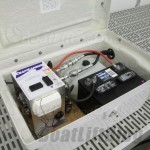 This lift is designed with a wide and low base (108” & 120” inside widths) that gives the unit stability; however, getting the boat centered on the rack will prevent any tipping as the cantilever motion proceeds. This unit is built from a heavy duty aluminum framework that is thicker and more robust than other lifts of this design; bringing speed, safety, style, and lift capacity to your boating lifestyle. Featuring an enclosed pump and battery box, charged by a solar panel on the cover of the box, this unit brings a whole lot of power and convenience in a very sleek package.
This lift is designed with a wide and low base (108” & 120” inside widths) that gives the unit stability; however, getting the boat centered on the rack will prevent any tipping as the cantilever motion proceeds. This unit is built from a heavy duty aluminum framework that is thicker and more robust than other lifts of this design; bringing speed, safety, style, and lift capacity to your boating lifestyle. Featuring an enclosed pump and battery box, charged by a solar panel on the cover of the box, this unit brings a whole lot of power and convenience in a very sleek package.
Single Cylinder Design
The single cylinder featured with this design eliminates the issue of binding or cylinders competing that can occur with other hydraulic systems. In multiple cylinder designs there can be discrepancies or misalignment between two or more cylinders that can result in an uneven lift; in short the more connections, i.e. hoses you have the more likely you will have leaks.
There are no uprights on the cantilever style and the look of the unit is very sleek and unobtrusive. In the down position, if you have a few feet of water, the lift disappears beneath the surface and when raised, there are no uprights to block or mar your view of the lake. Another interesting element to this lift is that in the down position, the cylinder is closed and therefore it is possible to leave the lift in the water, even under ice, as the cylinder is housed in oil that keeps it protected from the elements. This last feature highlights a key aspect to the hydraulic design, that being the combination of water and the cylinder that supplies the means of lift.
ShoreStation Hydraulic Lift
Shore Station’s hydraulic lifts take this combination of water and hydraulics into account and position the cylinder and the hoses above the water line, operating the lift cradle with cables to achieve a very sturdy, smooth, and powerful lift. The hydraulic lifts from Shore Station are designed for a vertical lift and are available in 4000, 6000, and 15000lb capacities. ShoreStation also brings this design to the boat house lift market with their Flex Power Hydraulic Boat House lift, available with AC and DC power options to run the pump.
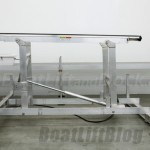 Hydraulic power has been a mainstay of industrial lifting for decades and the application of this style of lift to the boat hoist market has produced several effective and reliable products. The decision to go with a hydraulic lift should be made after an in depth discussion with a qualified lift dealer who can assist in determining your needs and options. In the end what you want is a safe, effective, and adequate lift for your boating needs, getting you out on the water, which after all is the whole point.
Hydraulic power has been a mainstay of industrial lifting for decades and the application of this style of lift to the boat hoist market has produced several effective and reliable products. The decision to go with a hydraulic lift should be made after an in depth discussion with a qualified lift dealer who can assist in determining your needs and options. In the end what you want is a safe, effective, and adequate lift for your boating needs, getting you out on the water, which after all is the whole point.
© 2013 BoatLiftandDock.com

